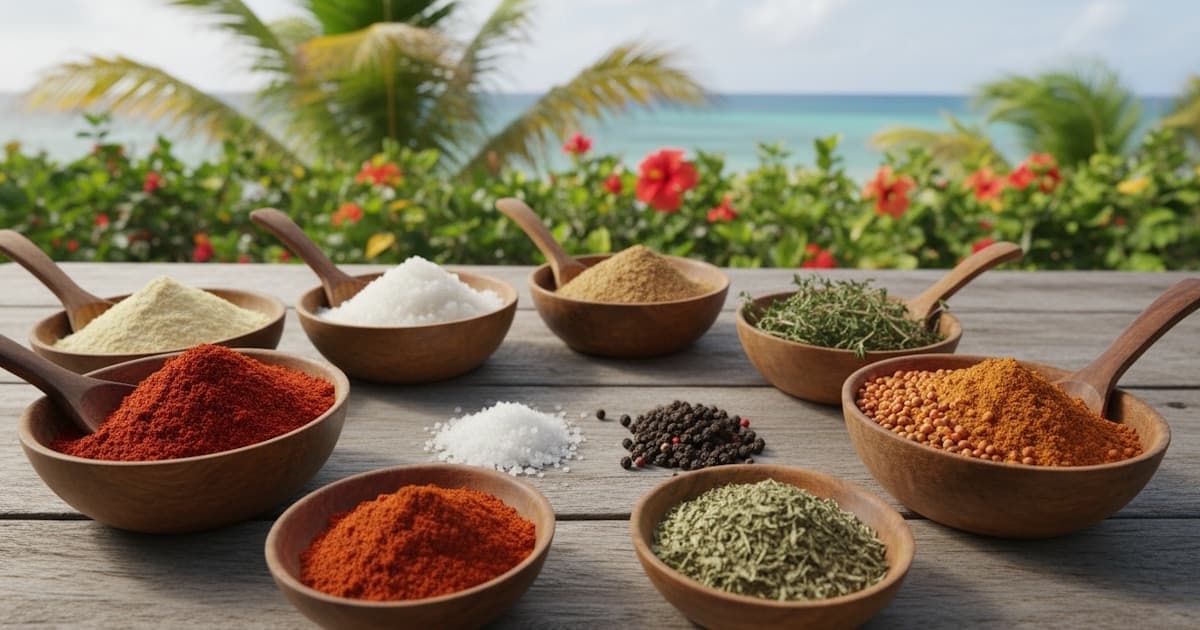
Best Herbs, Spices & Ingredients to Pair with Iguana Meat
Understanding Iguana's Flavor Profile
Here's the thing about iguana meat: it's beautifully mild and versatile. Think of it as a blank canvas waiting for your flavor artistry. The meat has a subtle sweetness with a texture that falls somewhere between chicken and firm white fish. This gentle character means iguana meat readily absorbs and showcases whatever seasonings you choose.
Some describe it as "chicken crossed with crab", soft, sweet, moist, and easy to enhance with delicate or bold spices. This makes pairing decisions both simple and exciting. You really can't go wrong, but knowing which flavors work best will elevate your dishes from good to unforgettable.
The Essential Spice Cabinet for Iguana Cookery
Before we dive into specific combinations, let's stock your spice cabinet with iguana-cooking essentials.
The Foundational Spices
Garlic powder - A non-negotiable base for nearly every iguana dish. Provides savory depth without overpowering the meat's natural flavor.
Onion powder - Partners perfectly with garlic to create a savory foundation. Adds subtle sweetness and complexity.
Paprika (both sweet and smoked varieties) - Sweet paprika adds color and mild pepper flavor; smoked paprika brings depth and a hint of barbecue character.
Cumin - Earthy and warm, cumin is essential for Latin American and Caribbean preparations. It adds that distinctive flavor associated with authentic regional cuisine.
Salt and black pepper - Obvious but crucial. Proper seasoning makes the difference between bland and brilliant.
The Character Players
Chili powder (or cayenne) - Brings heat and complexity. Start light and adjust to your preference.
Oregano (preferably Mexican oregano if you can find it) - Adds herbaceous, slightly citrusy notes that complement the meat beautifully.
Thyme - Essential in Caribbean cooking. Fresh or dried, it brings earthy, minty undertones.
Coriander - Citrusy and slightly sweet, excellent in curry blends and marinades.
Annatto (achiote) - Provides the characteristic red-orange color and subtle peppery flavor in traditional Caribbean preparations.
Regional Seasoning Blends That Work Perfectly
Why reinvent the wheel? These traditional spice combinations have been perfected over generations.
Caribbean Jerk Seasoning
Best for: Grilling, roasting, or any preparation where you want bold, complex heat.
Key components:
- Allspice (the star ingredient)
- Scotch bonnet or habanero pepper
- Thyme
- Garlic
- Ginger
- Cinnamon
- Nutmeg
Pro tip: Commercial jerk seasonings work well, but homemade versions allow you to control the heat level and showcase your iguana rather than overwhelming it. This seasoning is essential in traditional Caribbean cooking.
Cajun/Creole Seasoning
Best for: Frying, blackening, gumbo, and étouffée preparations.
Typical blend:
- Paprika
- Cayenne pepper
- Garlic powder
- Onion powder
- Oregano
- Thyme
- Black and white pepper
The magic of Cajun seasoning is how it creates that signature "Louisiana flavor" that pairs exceptionally well with iguana's mild meat.
Mexican Taco Seasoning
Best for: Tacos, fajitas, burrito fillings, and quick weeknight meals.
Classic components:
- Chili powder
- Cumin (generous amounts)
- Paprika
- Garlic powder
- Onion powder
- Oregano
- Crushed red pepper
This combination honors the traditional Mexican preparations while adding the familiar taco flavors everyone loves.
Curry Powder (Any Origin)
Best for: Stews, braised dishes, and slow-cooked preparations.
Whether you choose Indian-style curry powder, Caribbean curry, or Thai curry paste, iguana meat's texture and mild flavor make it exceptionally well-suited to curry preparations. The long cooking times typical in curry dishes ensure tender meat while the spices fully penetrate.
The Power of Fresh Herbs
Don't underestimate the transformative power of fresh herbs in iguana cookery.
Cilantro (Coriander Leaves)
When to use: Added fresh at the end of cooking or as garnish.
Cilantro's bright, citrusy flavor provides the perfect counterpoint to rich, long-cooked iguana stews. It's traditional in Belizean iguana preparations and Mexican tacos.
Note: If you're in the "cilantro tastes like soap" camp, substitute fresh parsley or simply omit.
Fresh Thyme
When to use: During cooking; holds up well to long braising.
A few sprigs of fresh thyme added to your braising liquid transform the entire dish. The essential oils release slowly, infusing the meat with subtle, complex flavor.
Bay Leaves
When to use: Add whole to stews and braises; remove before serving.
Bay leaves contribute a subtle depth that's hard to pinpoint but definitely missed when absent. They're particularly good in Caribbean-style stews.
Scallions (Green Onions)
When to use: During cooking and as fresh garnish.
Milder than onions, scallions add flavor without overwhelming. They're traditional in many Caribbean preparations and add visual appeal when sliced thin and scattered over finished dishes.
Marinade Foundations That Never Fail
The right marinade does double duty: tenderizing the meat while infusing it with flavor.
The Classic Citrus Marinade
Base formula:
- Lime juice or lemon juice (or combination)
- Olive oil
- Garlic (minced or pressed)
- Salt and pepper
- Your choice of herbs/spices
Why it works: The acid from citrus gently breaks down proteins, tenderizing the meat. Oil carries fat-soluble flavors into the meat. Garlic adds that essential savory note.
Marinating time: Minimum 1 hour, maximum overnight. Too long and the acid can make the exterior mushy.
The Vinegar-Based Marinade (Traditional Caribbean)
Base formula:
- White vinegar or apple cider vinegar
- Fresh lime juice
- Garlic
- Salt
- Hot peppers (optional)
This is the traditional approach in many Caribbean islands. The combination of vinegar and lime creates a powerful tenderizing effect while removing any potential gamey flavors.
The Coconut Milk Marinade (Exotic but Excellent)
Base formula:
- Coconut milk
- Lime juice
- Curry powder or paste
- Garlic and ginger
- Fish sauce (just a splash)
This Asian-inspired marinade creates incredibly tender, flavorful meat perfect for grilling or skewering. The fat in coconut milk keeps the meat moist during cooking.
Side Dishes and Accompaniments
What you serve alongside iguana is just as important as how you season the meat itself.
Traditional Caribbean Pairings
- Rice and peas (coconut rice with kidney beans or pigeon peas) - The classic accompaniment to Caribbean stewed iguana
- Fried plantains - Sweet or savory, they provide textural contrast and complement the meat's mild flavor
- Festival or Johnny cakes - Fried bread perfect for soaking up rich stew gravy
- Coleslaw - Crisp, acidic slaw cuts through rich preparations
Mexican-Style Accompaniments
- Mexican rice (arroz rojo) - Tomato-based rice provides flavor and bulk
- Black beans or refried beans - Essential taco and burrito partners
- Fresh salsa or pico de gallo - Bright, fresh flavors balance rich meat
- Guacamole - Creamy, cooling complement to spiced iguana
- Pickled jalapeños or escabeche - Tangy heat that brightens each bite
Universal Sides That Work
- Roasted root vegetables - Sweet potatoes, yuca, or cassava
- Simple green salad - Provides fresh contrast to rich preparations
- Grilled vegetables - Especially bell peppers, onions, and zucchini
- Cornbread - Particularly good with Cajun-style preparations
Beverage Pairings
The right drink elevates the entire meal.
Beer Pairings
- Caribbean lagers - Light, crisp beers like Red Stripe or Carib complement without overwhelming
- Mexican lagers - Corona, Pacifico, or Modelo work perfectly with taco preparations
- Wheat beers - For spicier preparations, the slight sweetness helps cool the heat
Non-Alcoholic Options
- Jamaican sorrel drink - Tart, refreshing, traditionally paired with Caribbean feasts
- Horchata - Sweet rice milk drink perfect with Mexican-style iguana
- Fresh lime water (agua de limón) - Simple, refreshing, cleansing between bites
- Coconut water - Natural, slightly sweet, very Caribbean
Wine Pairings (For the Fancy Occasions)
If you're serving iguana at a more refined gathering:
- Sauvignon Blanc - Bright acidity cuts through rich preparations
- Dry Riesling - Slight sweetness balances spicy seasonings
- Rosé - Versatile enough to handle various spice levels
- Light reds like Pinot Noir - For roasted preparations with robust seasonings
Building Your Own Signature Blend
Once you've experimented with traditional combinations, try creating your own signature seasoning blend. Start with a proven base and modify:
The Process:
- Choose a regional style as your foundation (Caribbean, Mexican, Cajun, or Asian)
- Keep the essential flavors (garlic, cumin, or whatever defines that style)
- Add one unexpected element (smoked paprika to a Caribbean blend, cinnamon to a Mexican blend)
- Test on a small batch
- Adjust and refine
- Name it something cool
The Golden Rules of Pairing
As you experiment, keep these principles in mind:
- Start with less - You can always add more seasoning, but you can't take it away
- Balance is key - Combine heat with acid, rich with fresh, bold with mild
- Respect the meat - Iguana's mild flavor is a feature, not a bug. Enhance it, don't bury it
- Consider cooking method - Grilled iguana can handle bolder seasonings than delicate stews
- Regional pairings exist for a reason - Traditional combinations have been refined over generations
Your Flavor Adventure Awaits
The beauty of iguana meat is its versatility. Whether you're craving the bold heat of jerk seasoning, the comforting warmth of curry, the familiar flavors of taco night, or the refined simplicity of citrus and herbs, iguana meat can deliver.
Start with traditional pairings to understand the foundations, then let your creativity guide you. Mix Caribbean and Asian influences. Try unexpected herb combinations. Create fusion dishes that honor tradition while forging new territory.
The mild, sweet meat is your canvas. The herbs, spices, and pairings? Those are your paints. Make sure you've mastered proper preparation techniques and cooking methods, then get in the kitchen and create your masterpiece.
What flavor combination will you try first?
Enjoyed this article? Share it!
Comments
Please log in to leave a comment
No comments yet. Be the first to comment!
